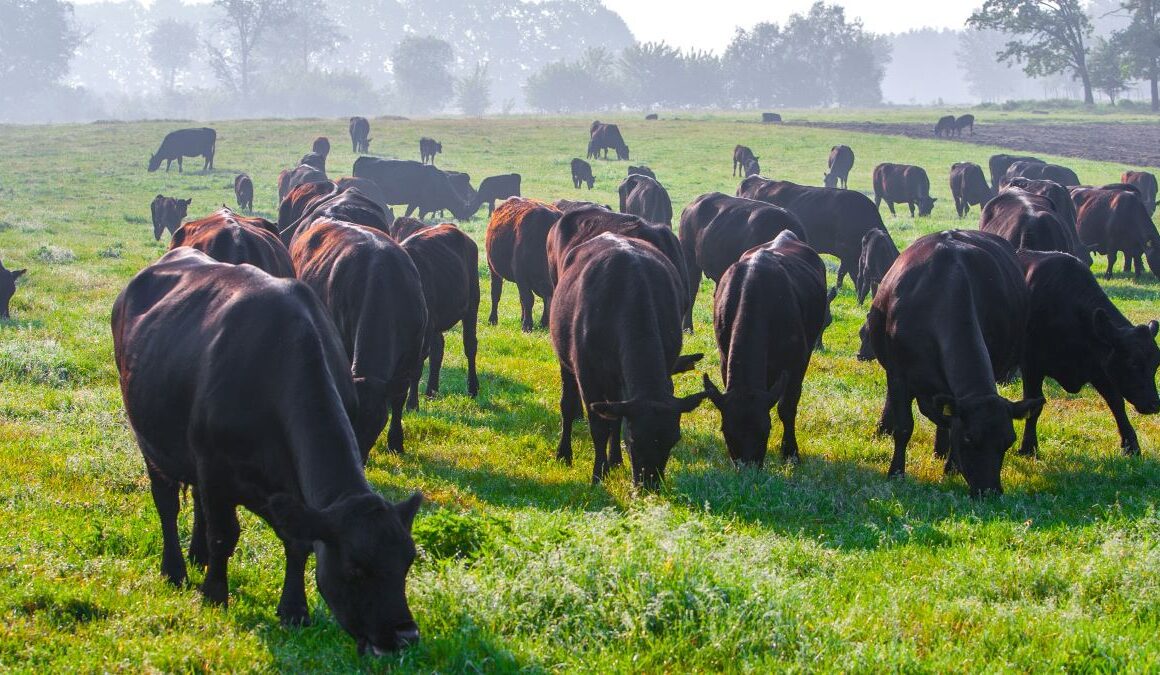Greener Grazing – Can Beef Become Sustainable?
Food production accounts for 26% of global greenhouse gas emissions. For Americans, meat is about 80% of our foodprint. Among meats, beef is second only to lamb in carbon emissions per kilogram. But we eat much more beef than lamb. Eating beef is bad for the environment, but does it have to be? A different approach to raising cattle is slowly taking hold, and it could make your burger’s carbon emissions bite-sized.
Beef’s Outsized Hoofprint
Unlike other meat production systems, beef is not vertically integrated, and practices can vary a lot, even within the U.S. Generally, beef production involves four phases: breeding, growing, finishing, and slaughter. Beef cattle live in a breeding herd for 6-10 months until they are weaned. Then they move to another herd on rangeland where they graze until between 12-16 months old. “Finishing” takes place for three to six months in a feedlot. These can range in size from a couple dozen animals to industrial CAFOs. In the feedlot, cattle bulk up on a grain diet before being sent to the slaughterhouse.
Consumer concern about concentrated animal feeding operations (CAFOs), combined with increased interest in lean meat, has encouraged some growers to eliminate the feedlot in favor of a longer grazer period. Cattle produced this way are called grass-finished or grass-fed.
The environmental impacts of CAFOs are significant. Feedlots concentrate and store manure, generating high levels of local air and water pollution. Runoff from nitrogen-rich manure can contribute to algal blooms and coastal “dead zones.” CAFOs are associated with the spread of pathogens such as E. coli, as well as exposure to growth hormones, antibiotics, and a host of chemicals used at the facilities. Further afield, feedlots contribute to deforestation through the conversion of land to agriculture to produce silage. Some people argue that feedlot finishing is more sustainable than grass finishing, citing a decrease in industry impacts over the time period when feedlots came to dominate production. However, many other changes took place during the same period, including a major shift in grazing practices on public land.

Grazing
Beef has an outsized impact even before it reaches the finishing stage. All cattle spend the majority of their life grazing. And even though grazing is better regulated than it was in generations past, there is still much room for improvement.
Pasture, or rangeland, is the single largest land use in the United States, occupying roughly a third of the contiguous states. About a quarter of that land, mostly in the Western states, is federally owned. Rangeland includes grasslands, as well as savannas, wetlands, some deserts, tundra, and shrub-dominated scrubland like chaparral. This last makes up much of the rangeland of the Western United States. It is much different from farm pastures and from the grasslands that once supported huge populations of grazing buffalo. Drier ecosystems are more fragile and prone to desertification from overgrazing, which was widespread from the period of Western expansion until the late 20th century.
Today, at least half of grazing operations still practice continuous grazing, in which cattle remain in the same area at low density for an entire year or growing season. There are several different approaches to rotational grazing, which allows pastures some period of rest. But variations in herd density, rotation frequency, and duration of fallow period can make a big difference in how sustainable a grazing operation is.
Adaptive Grazing
Many in the agriculture industry resist even weak rules and regulations protecting natural ecosystems. But some conservation-minded ranchers and academics are applying a philosophy of regenerative agriculture to rangeland management. Regenerative grazing systems can be called adaptive grazing, managed grazing, or holistic management. Regardless of nomenclature, sustainable grazing mimics the natural grazing patterns of native migratory herds. This involves carefully controlling livestock density and rotation schedules in response to local conditions rather than proscribed guidelines.
When managed correctly, regenerative grazing can build soil health and reduce nutrient loss. In March 2018, BLM selected 11 demonstration projects in six states to test regenerative grazing. These projects helped inform the new BLM rule guiding rangeland management that is open for public comment through June 20, 2023. This is BLM’s first real attempt to use the rulemaking process to put conservation on “equal footing” with other land uses.
Buying Better Beef
Shopping for sustainably grown meat isn’t easy, and unfortunately, the introduction of regenerative grazing adds a new layer of consumer research. Organic and humane certifications are compatible with regenerative grazing but may not require it. The American Grassfed Association requires beef producers to employ a regenerative approach to farm/ranch management. In 2018, the Regenerative Organic Alliance led by the Rodale Institute, Patagonia, and Dr. Bronner’s, introduced the Regenerative Organic Certification.
As always, whenever possible it is best to buy directly from the farmer. If you can’t find beef at your local farmers market, the website eatWild maintains a state-by-state directory of local farmers who sell their pastured products directly to consumers. Find one near you and give them a call. Farmers who work to leave the land better than they found it are happy to explain their practices to people who care about their food.


